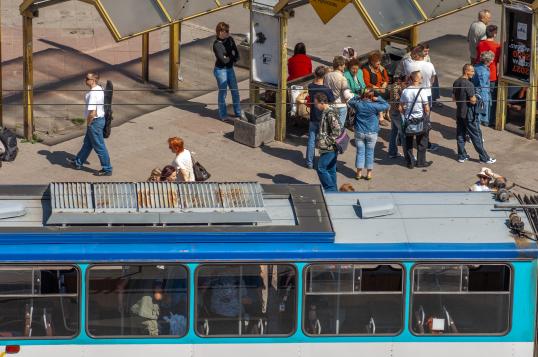- Topic
- Mobility management
- Public and stakeholder involvement
- Country
- Latvia
- Resource type
- Case study
First published on 24 June 2020.
The introduction of a mobility point involves the involvement of various stakeholders, such as the Department of Transportation, Public Transport Operator, Maintenance Department, Car and Bike Sharing Companies, local large companies and, of course, members of the public and local communities. It is therefore necessary to bring together the views and interests of the stakeholder group to develop and implement the Mobility Points concept. This case study has been created as a part of the cities.multimodal project.
Organising a stakeholder meeting is one of the most appropriate and relevant tools in this context: It is the process by which an organisation involves people who may be affected by the decisions it makes or can influence the implementation of its decisions. For each new policy tool addressed, a stakeholder group must be created in order to ensure that the urban project is not only at the level of the project leader, but also at the level of the organisation and stakeholders. Meetings are often educational and informative and cover general topics or new changes.
Context
With these stakeholder meetings, the objective for REA was to set up action for implementation of the VEF Mobility Point taking in count the stakeholder’s interests. The goal was also to inform and involve stakeholders in the implementation process. This method developed guidelines for the implementation of the Riga Mobility Point, as well as a conceptual solution for the VEF area (which was selected by the city of Riga as a pilot area to install the first mobility point). The stakeholder meetings were organised by the municipal company Riga Energy Agency (REA).
In action
For each meeting, one week of preparation was required to organise and plan the stakeholder meetings, but the full process takes some time. A well-organised meeting is key to make a positive impression on stakeholders and the following steps were used during the process;
- Identify the specific purpose of the stakeholder meeting, as well as the specific audience. For example, plan a meeting for suppliers to address changes in the internal purchasing process or a meeting with shareholders to keep them updated on an upcoming corporate merger. Use this purpose and the specific audience as a planning tool for the meeting.
- Write an agenda that covers each portion of the meeting. Determine how to begin the meeting, present the information and wrap up the meeting. Include key points on the agenda that will be covered to serve as an outline for presenters and meeting attendees.
- Write a list of questions or discussion topics that enables organisers to gain feedback from the stakeholders present at the meeting. Determine what type of information to glean from attendees beforehand. An example of information that may be sought is feedback on current products or services, as well as suggestions for how to improve them going forward.
- Assemble documents to be provided for stakeholders at the meeting. Provide handouts for relevant information, such as the past year's financial information for shareholders or investors.
- Schedule the meeting for a time and location that works for the majority of people involved. Choose a location with enough space to comfortably hold the number of people and facilitate the type of activities planned.
- Call the meeting to order on time so it doesn't run long. Follow the agenda and stay on schedule as much as possible while allowing attendees the chance to provide their individual input.
- Send out a copy of the minutes to all who attended the meeting as a method of following up. Encourage the participants to follow up with any questions or concerns after the conclusion of the meeting.
Results
The results of the first meeting: preparation of an action plan for stakeholder activities for the implementation of the VEF mobility point in the cities.multimodal project by 2020 and long-term activities beyond 2020; plan the next meeting.
Challenges, opportunities and transferability
Stakeholders meetings are also a way to avoid later conflict and to assure the support of all stakeholders on a new project. The most important point is to succeed in raising stakeholder interest in the mobility point concept. Information about the project upstream is therefore essential, as it allows stakeholders to realise the relevance of the project, and thus to ensure their support around the project.
The main challenge of stakeholder meetings is to succeed in mobilising stakeholders around a common project, and therefore to succeed in putting individual professional interest aside. However, it is also a way of taking into consideration all the issues and imperatives of the various stakeholders. A good balance must be found between a collective project and individual interests.
In Depth
This case study was created as a part of the cities.multimodal project and based on a report by janis [dot] andins riga [dot] lv (Jānis Andiņš) Senior Expert on Sustainable Transport & Mobility, City of Riga, Riga Energy Agency.
riga [dot] lv (Jānis Andiņš) Senior Expert on Sustainable Transport & Mobility, City of Riga, Riga Energy Agency.
This case study has been prepared for the European Commission however it reflects the views only of the authors, and the European Commission is not liable for any consequence stemming from the reuse of this publication.

